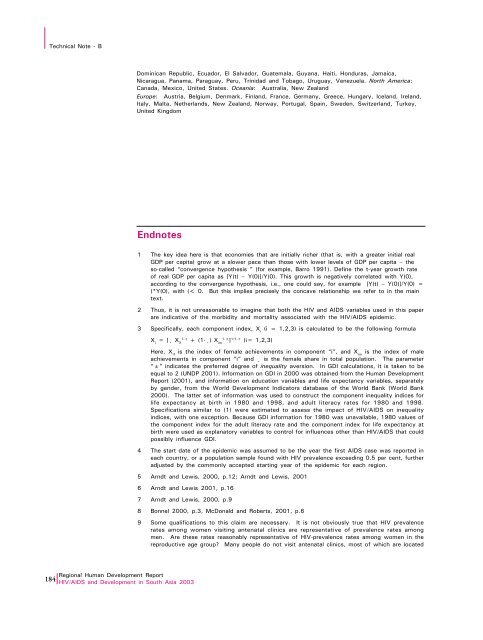Download Report - UNDP Asia-Pacific Regional Centre - United ...
Download Report - UNDP Asia-Pacific Regional Centre - United ...
Download Report - UNDP Asia-Pacific Regional Centre - United ...
You also want an ePaper? Increase the reach of your titles
YUMPU automatically turns print PDFs into web optimized ePapers that Google loves.
Technical Note - BDominican Republic, Ecuador, El Salvador, Guatemala, Guyana, Haiti, Honduras, Jamaica,Nicaragua, Panama, Paraguay, Peru, Trinidad and Tobago, Uruguay, Venezuela. North America:Canada, Mexico, <strong>United</strong> States. Oceania: Australia, New ZealandEurope: Austria, Belgium, Denmark, inland, rance, Germany, Greece, Hungary, Iceland, Ireland,Italy, Malta, Netherlands, New Zealand, Norway, Portugal, Spain, Sweden, Switzerland, Turkey,<strong>United</strong> KingdomEndnotes1 The key idea here is that economies that are initially richer (that is, with a greater initial realGDP per capita) grow at a slower pace than those with lower levels of GDP per capita – theso-called “convergence hypothesis ” (for example, Barro 1991). Define the t-year growth rateof real GDP per capita as [Y(t) – Y(0)]/Y(0). This growth is negatively correlated with Y(0),according to the convergence hypothesis, i.e., one could say, for example [Y(t) – Y(0)]/Y(0) =(*Y(0), with (< 0. But this implies precisely the concave relationship we refer to in the maintext.2 Thus, it is not unreasonable to imagine that both the HIV and AIDS variables used in this paperare indicative of the morbidity and mortality associated with the HIV/AIDS epidemic.3 Specifically, each component index, X i(i = 1,2,3) is calculated to be the following formulaX i= [¸ X if1-±+ (1-¸) X im1-±] 1/1-± (i= 1,2,3)Here, X ifis the index of female achievements in component “i”, and X imis the index of maleachievements in component “i” and ¸ is the female share in total population. The parameter“±” indicates the preferred degree of inequality aversion. In GDI calculations, it is taken to beequal to 2 (<strong>UNDP</strong> 2001). Information on GDI in 2000 was obtained from the Human Development<strong>Report</strong> (2001), and information on education variables and life expectancy variables, separatelyby gender, from the World Development Indicators database of the World Bank (World Bank2000). The latter set of information was used to construct the component inequality indices forlife expectancy at birth in 1980 and 1998, and adult literacy rates for 1980 and 1998.Specifications similar to (1) were estimated to assess the impact of HIV/AIDS on inequalityindices, with one exception. Because GDI information for 1980 was unavailable, 1980 values ofthe component index for the adult literacy rate and the component index for life expectancy atbirth were used as explanatory variables to control for influences other than HIV/AIDS that couldpossibly influence GDI.4 The start date of the epidemic was assumed to be the year the first AIDS case was reported ineach country, or a population sample found with HIV prevalence exceeding 0.5 per cent, furtheradjusted by the commonly accepted starting year of the epidemic for each region.5 Arndt and Lewis, 2000, p.12; Arndt and Lewis, 20016 Arndt and Lewis 2001, p.167 Arndt and Lewis, 2000, p.98 Bonnel 2000, p.3, McDonald and Roberts, 2001, p.69 Some qualifications to this claim are necessary. It is not obviously true that HIV prevalencerates among women visiting antenatal clinics are representative of prevalence rates amongmen. Are these rates reasonably representative of HIV-prevalence rates among women in thereproductive age group? Many people do not visit antenatal clinics, most of which are located<strong>Regional</strong> Human Development <strong>Report</strong>184 HIV/AIDS and Development in South <strong>Asia</strong> 2003
















